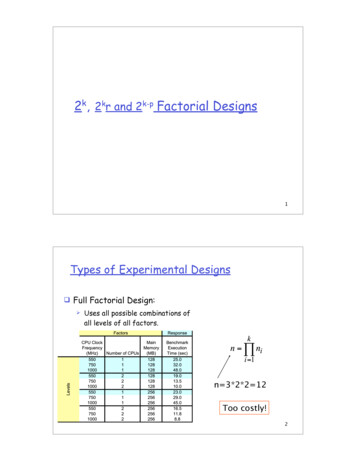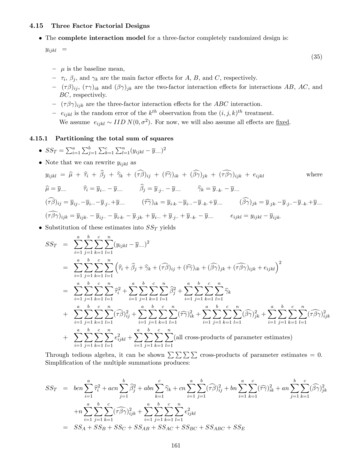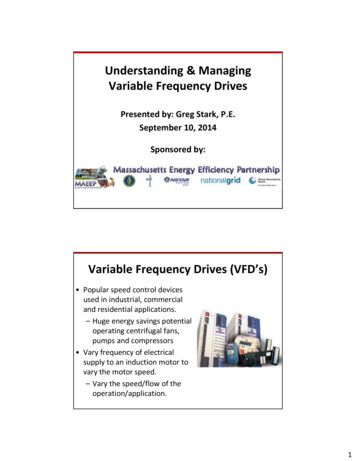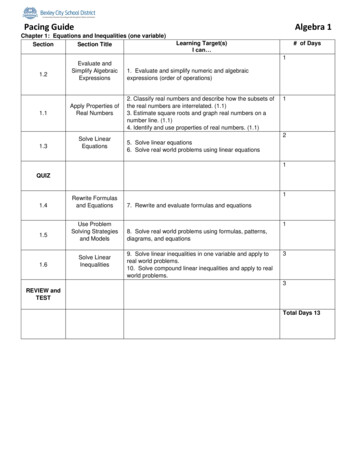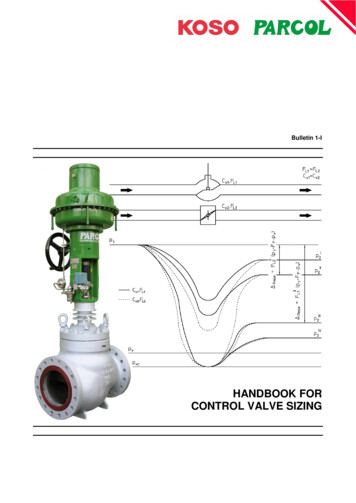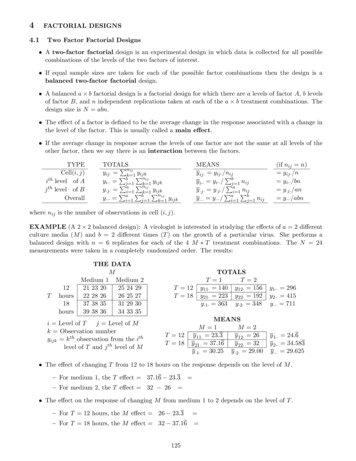
Transcription
4FACTORIAL DESIGNS4.1Two Factor Factorial Designs A two-factor factorial design is an experimental design in which data is collected for all possiblecombinations of the levels of the two factors of interest. If equal sample sizes are taken for each of the possible factor combinations then the design is abalanced two-factor factorial design. A balanced a b factorial design is a factorial design for which there are a levels of factor A, b levelsof factor B, and n independent replications taken at each of the a b treatment combinations. Thedesign size is N abn. The effect of a factor is defined to be the average change in the response associated with a change inthe level of the factor. This is usually called a main effect. If the average change in response across the levels of one factor are not the same at all levels of theother factor, then we say there is an interaction between the factors.TYPECell(i, j)ith level of Aj th level of BOverallTOTALSPnijyyij· k 1Pb Pijknijyyi·· j 1 k 1Pa Pnij ijky·j· i 1 k 1 yijkP PPnijyijky··· ai 1 bj 1 k 1MEANSy ij· yij· /nijPy i·· yi·· / bj 1 nijPy ·j· y·j· / ai 1 nijPa Pby ··· y··· / i 1 j 1 nij(if nij n) yij· /n yi·· /bn y·j· /an y··· /abnwhere nij is the number of observations in cell (i, j).EXAMPLE (A 2 2 balanced design): A virologist is interested in studying the effects of a 2 differentculture media (M ) and b 2 different times (T ) on the growth of a particular virus. She performs abalanced design with n 6 replicates for each of the 4 M T treatment combinations. The N 24measurements were taken in a completely randomized order. The results:T12hours18hoursTHE DATAMMedium 1 Medium 221 23 2025 24 2922 28 2626 25 2737 38 3531 29 3039 38 3634 33 35i Level of Tj Level of Mk Observation numberyijk k th observation from the ithlevel of T and j th level of MTOTALST 1T 2y11· 140 y12· 156y21· 223 y22· 192y·1· 363 y·2· 348T 12T 18T 12T 18MEANSM 1M 2y 11· 23.3y 12· 26y 21· 37.16y 22· 32y ·1· 30.25 y ·2· 29.00y1·· 296y2·· 415y··· 711y 1·· 24.6y 2·· 34.583y ··· 29.625 The effect of changing T from 12 to 18 hours on the response depends on the level of M .– For medium 1, the T effect 37.16 23.3– For medium 2, the T effect 32 26 The effect on the response of changing M from medium 1 to 2 depends on the level of T .– For T 12 hours, the M effect 26 23.3 – For T 18 hours, the M effect 32 37.16 125
If either of these pairs of estimated effects are significantly different then we say there exists asignificant interaction between factors M and T . For the 2 2 design example:– If 13.83 is significantly different than 6 for the M effects, then we have a significant M Tinteraction.Or,– If 2.6 is significantly different than 5.16 for the T effects, then we have a significant M Tinteraction. There are two ways of defining an interaction between two factors A and B:– If the average change in response between the levels of factor A is not the same at all levels offactor B, then an interaction exists between factors A and B.– The lack of additivity of factors A and B, or the nonparallelism of the mean profiles of A andB, is called the interaction of A and B. When we assume there is no interaction between A and B, we say the effects are additive. An interaction plot or treatment means plot is a graphical tool for checking for potentialinteractions between two factors. To make an interaction plot,1. Calculate the cell means for all a · b combinations of the levels of A and B.2. Plot the cell means against the levels of factor A.3. Connect and label means the same levels of factor B. The roles of A and B can be reversed to make a second interaction plot. Interpretation of the interaction plot:– Parallel lines usually indicate no significant interaction.– Severe lack of parallelism usually indicates a significant interaction.– Moderate lack of parallelism suggests a possible significant interaction may exist. Statistical significance of an interaction effect depends on the magnitude of the M SE :For smal values of the M SE , even small interaction effects (less nonparallelism) may be significant. When an A B interaction is large, the corresponding main effects A and B may have little practicalmeaning. Knowledge of the A B interaction is often more useful than knowledge of the main effect. We usually say that a significant interaction can mask the interpretation of significant main effects.That is, the experimenter must examine the levels of one factor, say A, at fixed levels of the otherfactor to draw conclusions about the main effect of A. It is possible to have a significant interaction between two factors, while the main effects for bothfactors are not significant. This would happen when the interaction plot shows interactions in differentdirections that balance out over one or both factors (such as an X pattern). This type of interaction,however, is uncommon.126
4.2The Interaction Model The interaction model for a two-factor completely randomized design is:yijk where(22)µ is the baseline mean,αi is the ith factor A effect,thβj is the j factor B effect,(αβ)ij is the (i, j)th A B interaction effect,th ijk is the random error of the k observation from the (i, j)th cell.We assume ijk IID N (0, σ 2 ). For now, we will also assume all effects are fixed. If (αβ)ij is removed from (22), we would have the additive model:yijk µ αi βj ijk(23) If we impose the constraintsaXi 1αi bXβj 0j 1aX(αβ)ij 0 for all jandi 1bX(αβ)ij 0 for all i,j 1then the least squares estimates of the model parameters areµb αbi βbj c αβij If we substitute these estimates into (22) we getc eijkyijk µb αbi βbj αβij y ··· (y i·· y ··· ) (y ·j· y ··· ) (y ij· y i·· y ·j· y ··· ) eijkwhere eijk is the k th residual from the treatment (i, j)th cell, and eijk For the 2 2 design,y ··· 29.625y 1· 24.6y 2· 34.586y ·1 30.25 Assuming the constraints in (24),α1α2β1β2αβ11αβ12αβ21αβ22 24.6 29.625 34.583 29.625 30.256 29.625 29.006 29.625 23.3 24.6 30.25 29.625 26 24.6 29.00 29.625 37.16 34.583 30.25 29.625 32 34.583 29.00 29.625 127y ·2 29.00(24)
128
4.3Matrix Forms for the Twoway ANOVAExample: Consider a completely randomized 2 3 factorial design with n 2 replications for each of thesix combinations of the two factors (A and B). The following table summarizes the results:Factor ALevels1211,23,5Factor B Levels234,65,65,74,6 Model: yijk µ αi βj (αβ)ij ijk for i 1, 2 j 1, 2, 3 k 1, 2 and ijk N (0, σ 2 )PP2(ii) 3j 1 βj 0 Assume (i)i 1 αi 0P3P(iii)(iv) 2i 1 (αβ)ij 0 for j 1, 2, 3j 1 (αβ)ij 0 for i 1, 2 Thus, for the main effect constraints, we have α2 α1 and β3 β1 β2 . The interaction effect constraints can be written in terms of just αβ11 and αβ12 :αβ12 αβ22 αβ13 αβ23 Thus, the reduced form of model matrix X requires only 6 columns: µ, α1 , β1 , β2 , αβ11 and αβ12 .µα1111111111111 X β1111111 1 1 1 1 1 1 XX 0 (X 0 X) 1 1 12 Thus, αb2 bα1 0.5c αβc 0αβ22121000001100 1 11100 1 1β2αβ110011 1 10011 1 11100 1 1 1 1001112 0 0 0 0 00 12 0 0 0 00 0 8 4 0 00 0 4 8 0 00 0 0 0 8 40 0 0 0 4 8000001000002 1000 12000002 1000 12αβ120011 1 100 1 111 y Xy 054-6-101-6-3 (X 0 X) 1 X 0 y βb3 βb1 βb2 0.75124656355746 4.5-0.5-1.751-0.750 µbαb1βb1βb2cαβ11cαβc αβc 0.75αβ2111c αβc αβc 0.75αβ131112129c αβc αβc 0.75αβ23111212
Alternate Approach: Keeping 1 a b (a b) Columnsµ X 0001111111000000β21100001100000100000β3 αβ11 αβ12 αβ13 αβ21 αβ22 10-301515-301515-2000-1080-1015-301515-3015 0XX 4-1476-1400000000110000010100000000000110001001 y 0Xy 542430112221310118121086 -45 -45 -20 -20 1 -20 180 -6 -6 -6 -6 -6(X 0 X) 1-45702000-0-10-10-101010-6 -14-1476-4-4-4-610 -10 15 15 -30 -4 -4 -4 -14 -14 76 1246563557460000000 0 1 0(X X) X y 4.5µb b1 -.5 α αb2 .5 b -1.75 β1 βb 2 1 βb 3 .75 c αβ -.75 11 c 0 αβ 12 c .75 αβ 13 c αβ .75 c 21 0 αβ 22 cαβ-.7523130
4.4Notation for an ANOVAaX SSA nb(y i·· y ··· )2 the sum of squares for factor A (df a 1)i 1M SA SSA /(a 1) the mean square for factor A SSB nabX(y ·j· y ··· )2 the sum of squares for factor B (df b 1)j 1M SB SSB /(b 1) the mean square for factor B SSAB na Xba XbXX(y ij· y i·· y ·j· y ··· )2[(y ij· y ··· ) (y i·· y ··· ) (y ·j· y ··· )]2 ni 1 j 1i 1 j 1 the A B interaction sum of squares (df (a 1)(b 1))M SAB SSAB /(a 1)(b 1) the mean square for the A B interaction 2P PP SSE ai 1 bj 1 nk 1 yijk y ij· the error sum of squares (df ab(n 1))M SE SSE /ab(n 1) the mean square error SST a Xb XnX(yijk y ··· )2 the total sum of squares (df abn 1)i 1 j 1 k 1 the total sum of squares is partitioned into components corresponding to the terms in the model:a Xb XnX2(yijk y ··· )abXX2 nb(y i·· y ··· ) na(y ·j· y ··· )2i 1 j 1 k 1i 1 nj 1a XbX2(y ij· y i·· y ·j· y ··· ) i 1 j 1nir XX(yij y i· )2i 1 j 1OR The alternate SS formulas for the balanced two factorial design are:SST a Xb XnX2 yijki 1 j 1 k 1SSAB a Xb2Xyij·i 1 j 1n2y···abnSSA aXy2i··i 1bn2y···abn SSA SSB 2y···abnSSB b2Xy·j·j 1an 2y···abnSSE SST SSA SSB SSAB The alternate SS formulas for the unbalanced two factorial design are:SST nija Xb XX2yijki 1 j 1 k 1SSAB a Xb2Xyij·i 1 j 1where N Pai 1Pbnijj 1 nijy2 ···NSSA Pbj 1 nijy2 ···ni·Ni··i 1 SSA SSB , ni· aXy22y···N, n·j 131SSB b2Xy·j·j 1n·j 2y···NSSE SST SSA SSB SSABPai 1 nij .
Balanced Two-Factor Factorial ANOVA TableSource ofVariationSum ofSquaresd.f.MeanSquareFRatioASSAa 1M SA SSA /(a 1)FA M SA /M SEBSSBb 1M SB SSB /(b 1)FB M SB /M SEA BSSAB(a 1)(b 1)M SAB SSAB /(a 1)(b 1)FA B M SAB /M SEErrorSSEab(n 1)M SE SSE /(ab(n 1))——TotalSStotalabn 1————For the unbalanced case, replace ab(n 1) with N ab for the d.f. for SSE and replace abn 1 with N 1P Pfor the d.f. for SStotal where N ai 1 bj 1 nij .4.5Comments on Interpreting the ANOVA TestH0 : (αβ)11 (αβ)12 · · · (αβ)ab vs. H1 : at least one (αβ)ij 6 (αβ)i0 j 0first.– If this test indicates that there is not a significant interaction, then continue testing the hypotheses for the two main effects:H0 : α1 α2 · · · αa vs.H1 : at least one αi 6 αi0H0 : β1 β2 · · · βb vs.H1 : at least one βj 6 βj 0– If this test indicates that there is a significant interaction, then the interpretation of significantmain effects hypotheses can be masked. To draw conclusions about a main effect, we will fixthe levels of one factor and vary the levels of the other. Using this approach (combined withinteraction plots) we may be able to provide an interpretation of main effects. If we assume the constraints in (24), then the hypotheses can be rewritten as:H0 : (αβ)11 (αβ)12 · · · (αβ)ab 0 vs.4.6H1 : at least one (αβ)ij 6 0H0 : α1 α2 · · · αa 0 vs.H1 : at least one αi 6 0H0 : β1 β2 · · · βb 0 vs.H1 : at least one βj 6 0ANOVA for a 2 2 Factorial Design Example We will now use SAS to analyze the 2 2 factorial design data discussed earlier.MT12hours18hoursMedium 121 23 2022 28 2637 38 3539 38 36132Medium 225 24 2926 25 2731 29 3034 33 35
ANOVA and Estimation of Effects for a 2x2 DesignThe GLM ProcedureDependent Variable: growthSourceSum ofSquares Mean Square F Value Pr FDFModel3 691.4583333230.4861111Error20 102.16666675.1083333Corrected Total23 793.625000045.12 .0001R-Square Coeff Var Root MSE growth Mean0.871266Source7.6292402.26016229.62500DF Type III SS Mean Square F Value Pr Ftime1 590.0416667medium1time*medium1590.0416667115.51 66718.020.0004ParameterStandardError t Value Pr t EstimateIntercept32.00000000B 0.9227073734.68 .0001time12-6.00000000B -4.240.0004.medium15.16666667B 1.30490528medium20.00000000B.time*medium 12 1-7.83333333time*medium 12 20.00000000B.time*medium 18 10.00000000B.time*medium 18 20.00000000B.B 1.84541474ANOVA and Estimation of Effects for a 2x2 DesignThe GLM ProcedureNote: The X'X matrix has been found to be singular, and a generalized inverse was used to solve the normal equations. Terms whose estimatesare followedVariable:by the letter'B' are not uniquely Error t Value Pr t mu29.62500000.4613536864.21 .0001time 12-4.95833330.46135368-10.75 .0001time 184.95833330.4613536810.75 .0001medium 10.62500000.461353681.350.1906medium 2-0.62500000.46135368-1.350.1906time 12 medium 1 -1.9583333 0.46135368-4.240.0004time 12 medium 21.95833330.461353684.240.0004time 18 medium 11.95833330.461353684.240.0004time 18 medium 2 -1.9583333 0.46135368-4.240.0004133
Dependent Variable: growthFit Diagnostics for growth1RStudent2RStudentResidual2 a2 of Effects for a 2x2 DesignANOVA and4 Estimation of Effects forANOVA2x2 Designand EstimationThe GLM Procedure 00The GLMProcedure0-1-2-1Distribution of growthDistribution of ercent25Fit–MeanResidual50357growthgrowth0.0 0.4 0.825ObservationObservations24Parameters4Error DF20MSE5.1083R-Square0.8713Adj R-Square 0.852300.0 250.4 0.8Proportion Less20201220Distribution of growth400315Residual5-530-7 -5 -3 -1 110ANOVA and Estimation of Effects for a 2x2 Design10255The GLM Procedure40350.10Predicted ValueDistribution of growth200.150.00The GLM Procedure300.300.0520ANOVA and Estimation of Effects for a 2x2 Design0.25Leverage0.2525400.2040-2035Cook's Dgrowth35growthResidual2-130Predicted Value4-2-225Predicted Value01201218 1181mediumtimemediumgrowthLevel oftimeNMeanStd Dev1212 24.66666672.774341311812 34.58333333.28794861Level oftimeN22timegrowthLevel ofmedium NgrowthMeanStd Dev1212 24.66666672.774341311812 34.58333333.28794861MeanStd Dev112 30.25000007.58137670212 29.00000003.71728151Level ofmedium N134growthMeanStd Dev112 30.25000007.58137670212 29.00000003.71728151
ANOVA and Estimation of Effects for a 2x2 DesignThe GLM ProcedureInteraction Plot for growth40growth353025201218time1medium of EffectsANOVA and Estimationfor a 2x22 DesignThe GLM ProcedureDistribution of growth40growth3530252012 112 218 1time*mediumgrowthLevel of Level oftimemedium NMeanStd Dev1216 23.33333333.076794871226 26.00000001.788854381816 37.16666671.471960141826 32.00000002.3664319113518 2
SignM-1.5 Pr M 0.6776Signed Rank S-10 Pr S 0.7681Tests for nov D4.6.1p Value0.966156Pr W0.57370.140751Pr D 0.1500Cramer-von MisesW-Sq 0.049547 Pr W-Sq 0.2500Anderson-DarlingA-Sq0.303234Pr A-Sq 0.2500SAS Code for 2 x 2 Factorial DesignDM ’LOG; CLEAR; OUT; CLEAR;’;ODS GRAPHICS ON;ODS PRINTER PDF file ’C:\COURSES\ST541\TWOWAY1.PDF’;OPTIONS NODATE *******;*** EXAMPLE: 2-FACTOR FACTORIAL (2x2) DESIGN **;DATA in;DO time 12 to 18 by 6;DO medium 1 to 2;DO rep 1 to 6;INPUT growth @@; OUTPUT;END; END; END;CARDS;21 23 20 22 28 2625 24 29 26 25 2737 38 35 39 38 3631 29 30 34 33 35;PROC GLM DATA in PLOTS (ALL);CLASS time medium;MODEL growth time medium / SS3 SOLUTION;MEANS time medium;*** Estimate mu ***;ESTIMATE ’mu’ intercept 1;*** Estimate the main effects for factor time’;ESTIMATE ’time 12’ time 1 -1 / divisor 2 ;ESTIMATE ’time 18’ time -1 1 / divisor 2 ;*** Estimate the main effects for factor medium’;ESTIMATE ’medium 1’ medium 1 -1 / divisor 2 ;ESTIMATE ’medium 2’ medium -1 1 / divisor 2 ;*** Estimate the interaction effects’;*** Take the product of the tau i and beta j coefficients;*** from the main effects ESTIMATE statement. Divisor a*b;***************To estimate taubeta i,j(1 -1) x (1 -1) (1 -1(1 -1) x (-1 1) (-1 1(-1 1) x (1 -1) (-1 1(-1 1) x (-1 1) (1 -1ESTIMATEESTIMATEESTIMATEESTIMATE’time 12’time 12’time 18’time 18medium 1’medium 2’medium 1’medium 2’-1 1)1 -1)1 -1)-1 e*mediumi,ji,ji,ji,j 1 -1-1 1-1 11 -112,1;12,2;18,1;18,2;-1 11 -11 -1-1 1////OUTPUT OUT diag P pred R resid;TITLE ’ANOVA and Estimation of Effects for a 2x2 Design’;PROC UNIVARIATE DATA diag NORMAL;VAR resid;RUN;136divisordivisordivisordivisor 4;4;4;4;
4.7Tests of Normality (Supplemental) For an ANOVA, we assume the errors are normally distributed with mean 0 and constant varianceσ 2 . That is, we assume the random error N (0, σ 2 ). The Kolmogorov-Smirnov Goodness-of-Fit Test, the Cramer-Von Mises Goodness-of-Fit Test, andthe Anderson-Darling Goodness-of-Fit Test can be applied to any distribution F (x). Although the following notes use the general form F (x), we will be assuming F (x) represents anormal distribution with mean 0 and constant variance. We are also assuming that the random sample referred to in each test is the set of residuals from theANOVA. Thus, in each each test we are checking the normality assumption in the ANOVA. In this case, wewant to see a large p-value because we do not want to reject the null hypothesis that the errors arenormally distributed.4.7.1Kolmogorov-Smirnov Goodness-of-Fit TestAssumptions: Given a random sample of n independent observations The measurement scale is at least ordinal. The observations are sampled from a continuous distribution F (x).Hypotheses: For a hypothesized distribution F (x)(i) Two-sided:H0 : F (x) F (x) for all x vs. H1 : F (x) 6 F (x) for some x(ii) One-sided: H0 : F (x) F (x) for all x vs. H1 : F (x) F (x) for some x(iii) One-sided: H0 : F (x) F (x) for all x vs. H1 : F (x) F (x) for some xMethod: For a given α Define the empirical distribution function Sn (x) Number of observations xn(i) Two-sided test statistic: T sup F (x) Sn (x) x When plotted, T is the greatest vertical difference between the empirical and the hypothesized distribution.(ii) One-sided test statistic: T sup(F (x) Sn (x))x(iii) One-sided test statistic: T sup(Sn (x) F (x))xDecision Rule Critical values for T , T and T are found in nonparametrics textbooks. For larger samples sizes,an asymptotic critical value can be used. We will just rely on p-values to make a decision.137
4.7.2Cramer-Von Mises Goodness-of-Fit TestAssumptions: Same as the Kolmogorov-Smirnov testHypotheses: For a hypothesized distribution F (x)H0 : F (x) F (x) for all xvs.H1 : F (x) 6 F (x) for some xMethod: For a given α Define the empirical distribution function Sn (x) Number of observations xn The Cramer-von Mises test statistic W 2 is defined to beZ W2 n[F (x) Sn (x)]2 dF (x). n X12i 1 2 This form can reduces to W F (x(i) ) 12n2ni 1where x(1) , x(2) , . . . , x(n) represents the ordered sample in ascending order.2Decision Rule Tables of critical values exist for the exact distribution of W 2 when H0 is true. Computers generatecritical values for the asymptotic (n ) distribution of W 2 . If W 2 becomes too large (or p-value α), then we will Reject H0 .4.7.3Anderson-Darling Goodness-of-Fit TestAssumptions: Same as the Kolmogorov-Smirnov and Cramer-von Mises testsHypotheses: Same as the Cramer-von Mises test.Method: For a given α Define the empirical distribution function Sn (x) Number of observations xn The Anderson-Darling test statistic A2 is defined to beZ 12A [F (x) Sn (x)]2 dx. F (x)(1 F (x)) 1 This form can reduces to A2 (2i 1) lnF (x(i) ) ln(1 F (x(n 1 i) ) n wherenx(1) , x(2) , . . . , x(n) represents the ordered sample in ascending order.Decision Rule Computers generate critical values for the asymptotic (n ) distribution of A2 . If A2 becomes too large (or p-value α), then we will Reject H0 .138
A two-factor factorial design is an experimental design in which data is collected for all possible . An interaction plot or treatment means plot is a graphical tool for checking for potential interactions between two factors. To make an interaction plot, 1. Calculate the c
